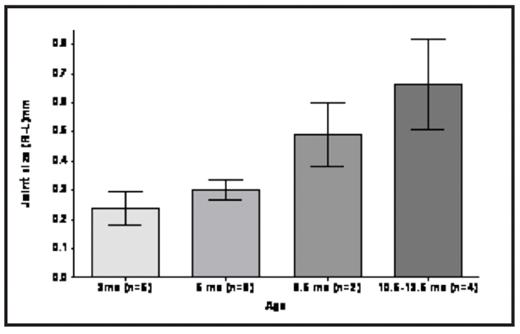Abstract
The National Hemophilia Foundation, World Federation for Hemophilia and the World Health Organization recommend that prophylaxis be continued indefinitely. Questions about stopping prophylaxis as boys become adolescents or adults have been raised. In particular, discontinuing prophylaxis after a boy reaches skeletal maturity has been suggested. The impact of joint bleeding on these mature joints is thought to be less deleterious than in those of younger patients. To test the hypothesis that older, skeletally mature joints are less susceptible to joint damage after hemarthrosis, mice deficient in factor 8 gene expression (n=42) were studied to determine the impact of age and skeletal maturity on the development of hemophilic arthropathy. Mice at different ages were subjected to needle puncture of the knee joint capsule to induce a single massive hemarthrosis and then sacrificed 30 days or one year after the joint bleed. The diameter of the right (R) and left (L) knee joints was measured and the greatest bone diameter recorded. The joints were then isolated and subjected to image analysis using micro-computed tomography (mCT). Images were reviewed by 6 examiners blinded to the experimental conditions. After 30 days, a single episode of hemarthrosis resulted in a significant increase (p=0.0152) in the size of the affected joints compared to the control contralateral joint (figure). Although all ages of mice demonstrated bone hypertrophy, this was most pronounced in older mice. mCT images showed that changes were present in bones of the affected knees both young and old mice compared to the contralateral control joints. A pitted appearance of the surface was prominent in young mice early after a joint bleed (day 30). By one year, this pitting was much less evident. Osteocyte formation was a prominent feature. The surface contour of older mice scarified on day 30 was rugose. By one year, osteocyte and new bone formation dominated the surface. Consistent with the observation in patients with hemophilia, the patella of older mice was laterally displaced. The knee joints of both young, skeletally immature and older skeletally mature mice demonstrate marked structural changes after a single hemarthrosis. These results indicate:
that bone hypertrophy is greater in older mice;
the blood-induced joint damage is different depending on the age of the animal;
that bleeding into the skeletally mature joint damages the bones resulting in new bone formation;
bleeding into immature joints causes more pitting of the surface and bone changes.
Therefore, in conclusion, this data does not support the hypothesis that bleeding into the mature joint is less detrimental compared to hemarthrosis in the younger skeletally immature joint. This observation, if translatable to humans suggests that joint bleeding in adults is likely to result in bone damage and that prevention of joint bleeding should be a goal for patients of all ages.
Disclosures: No relevant conflicts of interest to declare.
Author notes
Corresponding author


This feature is available to Subscribers Only
Sign In or Create an Account Close Modal